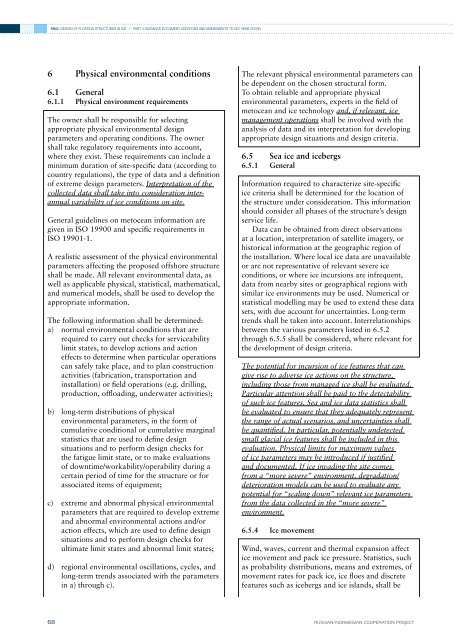phase 4 report - DNV
phase 4 report - DNV
phase 4 report - DNV
You also want an ePaper? Increase the reach of your titles
YUMPU automatically turns print PDFs into web optimized ePapers that Google loves.
RN02: DESIGN OF FLOATING STRUCTURES IN ICE // PART 4 Guidance Document: Additions and Amendments to ISO 19906:2010(E)6 Physical environmental conditions6.1 General6.1.1 Physical environment requirementsThe owner shall be responsible for selectingappropriate physical environmental designparameters and operating conditions. The ownershall take regulatory requirements into account,where they exist. These requirements can include aminimum duration of site-specific data (according tocountry regulations), the type of data and a definitionof extreme design parameters. Interpretation of thecollected data shall take into consideration interannualvariability of ice conditions on site.General guidelines on metocean information aregiven in ISO 19900 and specific requirements inISO 19901-1.A realistic assessment of the physical environmentalparameters affecting the proposed offshore structureshall be made. All relevant environmental data, aswell as applicable physical, statistical, mathematical,and numerical models, shall be used to develop theappropriate information.The following information shall be determined:a) normal environmental conditions that arerequired to carry out checks for serviceabilitylimit states, to develop actions and actioneffects to determine when particular operationscan safely take place, and to plan constructionactivities (fabrication, transportation andinstallation) or field operations (e.g. drilling,production, offloading, underwater activities);b) long-term distributions of physicalenvironmental parameters, in the form ofcumulative conditional or cumulative marginalstatistics that are used to define designsituations and to perform design checks forthe fatigue limit state, or to make evaluationsof downtime/workability/operability during acertain period of time for the structure or forassociated items of equipment;c) extreme and abnormal physical environmentalparameters that are required to develop extremeand abnormal environmental actions and/oraction effects, which are used to define designsituations and to perform design checks forultimate limit states and abnormal limit states;d) regional environmental oscillations, cycles, andlong-term trends associated with the parametersin a) through c).The relevant physical environmental parameters canbe dependent on the chosen structural form.To obtain reliable and appropriate physicalenvironmental parameters, experts in the field ofmetocean and ice technology and, if relevant, icemanagement operations shall be involved with theanalysis of data and its interpretation for developingappropriate design situations and design criteria.6.5 Sea ice and icebergs6.5.1 GeneralInformation required to characterize site-specificice criteria shall be determined for the location ofthe structure under consideration. This informationshould consider all <strong>phase</strong>s of the structure’s designservice life.Data can be obtained from direct observationsat a location, interpretation of satellite imagery, orhistorical information at the geographic region ofthe installation. Where local ice data are unavailableor are not representative of relevant severe iceconditions, or where ice incursions are infrequent,data from nearby sites or geographical regions withsimilar ice environments may be used. Numerical orstatistical modelling may be used to extend these datasets, with due account for uncertainties. Long-termtrends shall be taken into account. Interrelationshipsbetween the various parameters listed in 6.5.2through 6.5.5 shall be considered, where relevant forthe development of design criteria.The potential for incursion of ice features that cangive rise to adverse ice actions on the structure,including those from managed ice shall be evaluated.Particular attention shall be paid to the detectabilityof such ice features. Sea and ice data statistics shallbe evaluated to ensure that they adequately representthe range of actual scenarios, and uncertainties shallbe quantified. In particular, potentially undetectedsmall glacial ice features shall be included in thisevaluation. Physical limits for maximum valuesof ice parameters may be introduced if justifiedand documented. If ice invading the site comesfrom a “more severe” environment, degradation/deterioration models can be used to evaluate anypotential for “scaling down” relevant ice parametersfrom the data collected in the “more severe”environment.6.5.4 Ice movementWind, waves, current and thermal expansion affectice movement and pack ice pressure. Statistics, suchas probability distributions, means and extremes, ofmovement rates for pack ice, ice floes and discretefeatures such as icebergs and ice islands, shall be68RUSSIAN–NORWEGIAN COOPERATION PROJECT






![Risk Based Pipeline Integrity Management [Compatibility Mode] - DNV](https://img.yumpu.com/50424229/1/190x146/risk-based-pipeline-integrity-management-compatibility-mode-dnv.jpg?quality=85)









